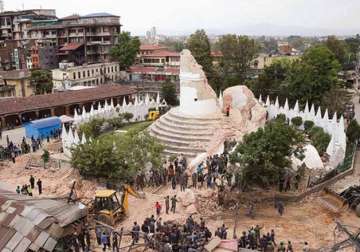Nepal earthquake: 5 major losses to Nepal's historic structures!
The 7.9-magnitude earthquake that took the lives of over 6,000 people could only be described as a never ending 'nightmare.'During this disaster the country witnessed many of its cultural heritages turning into rubbles and losing

The 7.9-magnitude earthquake that took the lives of over 6,000 people could only be described as a never ending 'nightmare.'
During this disaster the country witnessed many of its cultural heritages turning into rubbles and losing many of the cultural sites listed by the UNESCO. Nepal is home to eight of the ‘UNESCO World Heritage cultural sites.'
Many of these historical monuments were earlier damaged in the 8.1 magnitude earthquake of 1934, which were rebuilt after sometime.
These monuments that used to provide peace were guarded in a highly manner by respective communities of that areas. They were not just museums or some sort of ornate structures standing still to give pleasure but they were Nepal's identity standing and preserving history in Nepal's lap.
Let's take a look at what Nepal has lost so far that were a major part of Nepal and Nepal's World Heritage sites:
Kathmandu valley has three main cities that it is proud of – Kathmandu, Patan and Bhaktapur – each built around rambling medieval palace complex and each was with a public square that contained shrines and temples.
Kathmandu Durbar Square
Kathmandu Durbar Square, also known as Nepal's Durbar Square, or a palace square, is surrounded by scenic beauty and lots of small historic temples.
Following the quake, Kathmandu Durbar Square witnessed severe damage. Major parts of the Hanuman Dhoka, the city's oldest palace that was built by the Malla kings in the 16th century collapsed, along with several pagoda styled temples.
Bhaktapur Durbar Square
Bhaktapur, the “City of Devotees” located 20 km east of Kathmandu was the best conserved among the Nepal's oldest cities. This place was also severely damaged in the 1934 earthquake.
As per the reports, 80 per cent of the temples around the Durbar Square are destroyed, including the 18th-century Vatsala Durga temple (gigantic sandstone structure that induced the peaks surrounding the city). These places were mostly visited by tourists.
Patan Durbar Square
Built in the 17th century, Patan Durbar Square located in the heart of Lalitpur (south- central Ktm valley) was a royal palace complex loved and visited by locals as well as tourists. It was one of the preserved seats of the Nepal's three kingdoms.
Char Narayan Mandir, Yog Narendra Malla's statue, Taleju temple, the Hari Shanker, Uma Maheshwor temple and the Machhindranath Temple in Bungmati were completely destroyed.
Patan Darbar Square in Kathmandu Valley was the most loved World Heritage Site, but, the temblor didn't spare and reduced the cultural icon to rubble.
The most important temple in the Durbar Square, the Krishna Mandir too couldn't survive and was demolished by the quake
Dharahara
Built in 1832, under the commission of the then Prime Minister Bhimsen Thapa- the iconic ‘Dharahara' tower also famous as Bhimsen Tower was a nine-storey, 61.88-metre-tall (203.0 ft) tower at the center of Sundhara in Kathmandu. The iconic tower Dharahara had broken into parts in a similar quake that occurred around 83 years ago.
Durbar High School
Opened in 1892 and located in Ranipokhari, Durbar High School of Kathmandu is the oldest modern school in Nepal.
The scariest earthquake also didn't spare this old-age school that was providing education to many of the country's future.
ALSO READ: Know more about Dharahara ‘Bhimsen Tower' that turned into rubble after Nepal quake
Several temples, including Kasthamandap (16th century wooden monument), Panchtale temple, the nine-storey Basantapur Durbar, the Dasa Avtar temple, Krishna Mandir and two dewals located behind the Shiva Parvati temple, too were demolished by the quake.
Though one cannot restore the pagoda style temples and historic structures as it was but we wish Nepal gets its cultural heritage site back in less time possible.